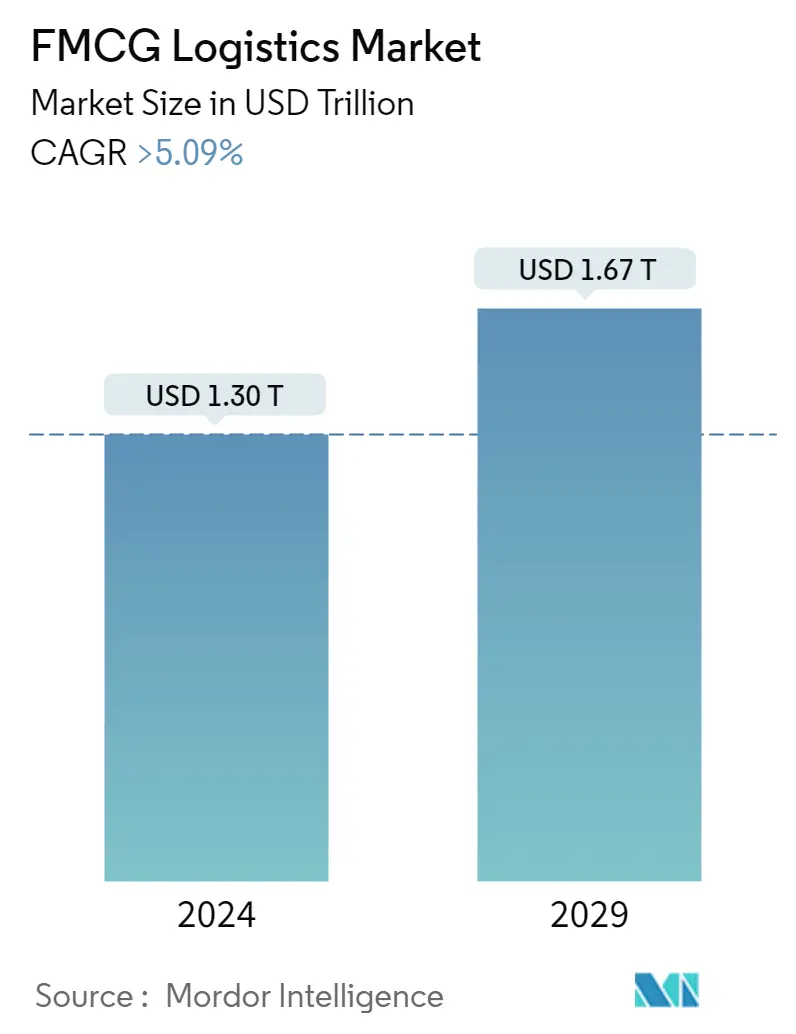
| Study Period | 2019 - 2029 |
| Market Size (2024) | USD 1.30 Trillion |
| Market Size (2029) | USD 1.67 Trillion |
| CAGR (2024 - 2029) | 5.09 % |
| Fastest Growing Market | Asia Pacific |
| Largest Market | North America |
| Market Concentration | Low |
Major Players
*Disclaimer: Major Players sorted in no particular order |
FMCG Logistics Market Analysis
The FMCG Logistics Market size is estimated at USD 1.30 trillion in 2024, and is expected to reach USD 1.67 trillion by 2029, growing at a CAGR of greater than 5.09% during the forecast period (2024-2029).
- FMCG is considered a unique business model that requires competitive advantages in manufacturing, branding, advertising, and logistics. The key growth drivers for the consumer goods industry are changing lifestyles, ease of access, and rapidly changing consumer habits. Consumers expect a wide array of products to be always available in local stores and online. to achieve this, consumer goods companies tie up with global supply chains that are highly efficient, agile, and sustainable. FMCG manufacturers are adopting collaborative logistics solutions that deliver products to stores faster and more cost-effectively. The recent e-commerce boom has also been a blessing for the FMCG industry.
- From traditional storekeeping, purchasing, materials management, and integrated materials management, the industry is entering a new era of supply chain management. The logistics operations in FMCG businesses are typically operated on a hub-and-spoke model type with distribution hubs in major towns and cities serving both the wholesalers and retailers. Consumers are expecting fast order fulfilment through multiple channels. To make this possible, consumer goods companies outsource their logistics operations to bridge the gap between sales planning and operational processes, improve forecasting, streamline inventory, and speed up delivery times.
- FMCG players are expected to rely more on logistics service providers (LSPs) to meet demand from new consumption patterns. Investment in supply chain automation, expansion of existing manufacturing facilities, and the emergence of warehouse hubs are essential areas of focus in the current market study. Distribution facilities and locations, along with a strong supply chain strategy, will play a critical role in the success of FMCG operators soon. To maintain a better competitive position and access key demand demographics, businesses will need to consider the location strategically to meet the growing demand.
FMCG Logistics Industry Segmentation
FMCG logistics management is concerned with the efficiency and effectiveness with which daily activities involving the transportation of daily usable goods from one location to another are managed. It is the management of the flow of goods from one point of origin to another to meet the needs of customers.
A complete background analysis of the FMCG Logistics Market, including the assessment of the economy and contribution of sectors in the economy, market overview, market size estimation for key segments, and emerging trends in the market segments, market dynamics, and geographical trends, and COVID-19 impact is included in the report.
The FMCG logistics market is segmented by service (transportation, warehousing, distribution, inventory management, and other value-added services), and by geography (Asia-Pacific, North America, Europe, Latin America, Middle East and Africa). The report offers market size and forecasts in value (USD) for all the above segments.
| Transportation |
| Warehousing, Distribution, and Inventory Management |
| Other Value-added Services |
| Food and Beverage |
| Personal Care |
| Household Care |
| Other Consumables |
| Asia-Pacific |
| North America |
| Europe |
| Latin America |
| Middle East and Africa |
FMCG Logistics Market Size Summary
The FMCG logistics market is poised for significant growth, driven by evolving consumer behaviors and the increasing demand for efficient supply chain solutions. As consumer preferences shift towards convenience and rapid availability of products, FMCG companies are leveraging global supply chains that are agile and sustainable. The integration of e-commerce has further accelerated this trend, with companies adopting collaborative logistics solutions to enhance product delivery speed and cost-effectiveness. The industry is transitioning from traditional supply chain models to more sophisticated hub-and-spoke systems, enabling faster order fulfillment through multiple channels. This shift is supported by strategic outsourcing of logistics operations, which helps bridge the gap between sales planning and operational processes, improve forecasting, and streamline inventory management.
The expansion of online FMCG sales is a key driver of market growth, with e-commerce increasingly becoming a dominant force in the retail sector. Despite logistical challenges in ensuring the quality of perishable goods, advancements in technology and consumer demand for convenience are propelling online FMCG growth, particularly in developing markets. The Asia region is expected to offer substantial growth opportunities, with online sales anticipated to double globally. The market is characterized by a mix of large global players and smaller local entities, all striving to enhance their logistics capabilities. Companies are investing in digital analytics and personalized solutions to capture market share, while the fragmented nature of the market allows for diverse strategies in inventory handling and service offerings.
FMCG Logistics Market Size - Table of Contents
1. MARKET SEGMENTATION
-
1.1 By Service
- 1.1.1 Transportation
- 1.1.2 Warehousing, Distribution, and Inventory Management
- 1.1.3 Other Value-added Services
-
1.2 By Product Category
- 1.2.1 Food and Beverage
- 1.2.2 Personal Care
- 1.2.3 Household Care
- 1.2.4 Other Consumables
-
1.3 Geography
- 1.3.1 Asia-Pacific
- 1.3.2 North America
- 1.3.3 Europe
- 1.3.4 Latin America
- 1.3.5 Middle East and Africa
FMCG Logistics Market Research FAQs
How big is the FMCG Logistics Market?
The FMCG Logistics Market size is expected to reach USD 1.37 trillion in 2025 and grow at a CAGR of greater than 5.09% to reach USD 1.75 trillion by 2030.
What is the current FMCG Logistics Market size?
In 2025, the FMCG Logistics Market size is expected to reach USD 1.37 trillion.


